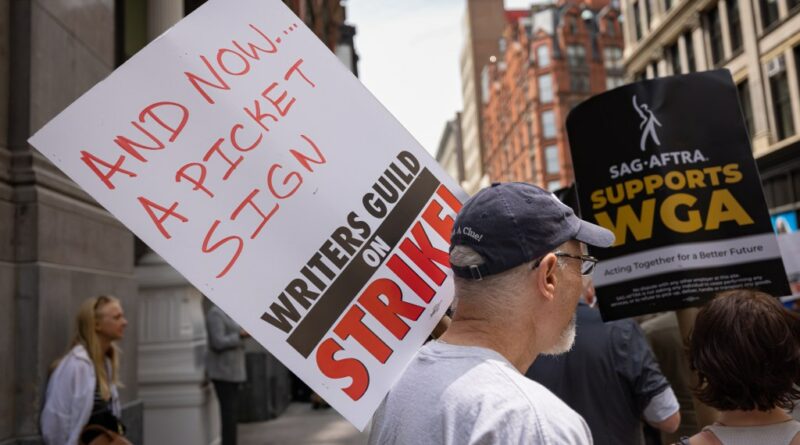Writers Strike Hits Four-Month Mark as Resolve on Both Sides Hardens, Complicating the Return to Negotiations
The writers strike reached the four-month mark on Saturday, and as Hot Labor Summer moves to autumn, there is still no sign that it will be over any time soon.
The Writers Guild of America and the Alliance of Motion Picture and Television Producers have not talked in two weeks. Both maintain that the ball is in the other’s court.
Far from resolving the strike, the parties face a delicate challenge of finding their way back into the negotiating room. The WGA is open to talking, but has let the AMPTP make the first move. The AMPTP could invite the writers back — as it did on Aug. 1 — but it has nothing new to offer.
“Obviously we’re not backing down,” said one writer. “They’re going to have to come up with something.”
On the studio side, there is continuing frustration that the writers have not made bigger concessions. The AMPTP made proposals on Aug. 11 in several areas that it had previously refused to discuss, including a second step for original screenplays, access to viewership data, and a showrunner option to hire at least two writers per show. In its Aug. 15 response, the WGA came down slightly on some numbers, but largely held to its original positions. The management side believes a further move on its part would amount to little more than “negotiating against ourselves.”
“The Writers Guild isn’t giving the studios much of an opportunity to find a solution,” said one studio-side labor veteran. “It’s one thing to say, ‘OK, let’s find a way to get this done.’ But it takes two to tango.”
In the absence of talks, both sides have nurtured hopes that the other side would break ranks under the pressure, which thus far have not panned out.
Some writers have expressed a certain restlessness, especially as Labor Day has arrived with little hope of salvaging scripted series for the 2023-24 network television season. WGA members have not received an update from the union for more than a week, leaving many with little sense of where things stand in the negotiatons.
Yet the WGA membership has remained far more united than in the 2007-08 strike, when the level of solidarity was weakening by the time the strike ended on its 100th day.
There have been rumors about dissident factions of showrunners this time around, but no revolts have emerged to date. One reason may have to do with the WGA’s recent experience of taking on the industry’s largest talent agencies to reform the decades-old practice of agencies receiving packing fees from studios for helping clients assemble TV series and movies. In the midst of that two-year effort, in 2019, hundreds of dissenting writers signed an open letter urging WGA leadership to settle the dispute. But that only served to deepen tensions in the guild without altering the course of the campaign. The WGA prevailed and imposed a new conflict of interest code on talent agents.
Likewise, there has been no sign that any of the studios or streamers will break away from the AMPTP and make a separate agreement with the writers. Despite much speculation about fissures between the tech upstarts (Netflix, Amazon, Apple) and Hollywood’s old-guard (Warner Bros. Discovery, Comcast, Paramount Global and Sony Pictures Entertainment), sources on the management side say there’s been disagreements on strategy and tactics but not on the larger goal. If anything, one person with direct knowledge of the situation says, the bashing of CEOs and studios on picket lines and in social media amid the dual WGA and SAG-AFTRA strikes has only drawn the industry’s executive leaders closer amid crisis.
In its last communication to members, the WGA acknowledged that the AMPTP had made “progress,” while also saying that the most recent offer was “not yet good enough.” The “yet” suggested that further work could improve it — but so far that hasn’t happened.
“The CEOs are paralyzed,” the writer said. “They didn’t expect us to be so powerful. Now they don’t know what to do.”
Cynthia Littleton contributed to this story.
Read More About:
Source: Read Full Article



